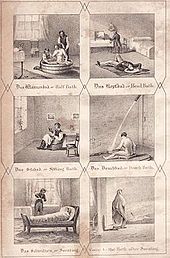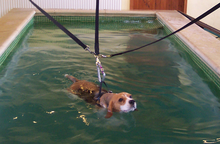
Bathing is the act of washing the body, usually with water, or the immersion of the body in water. It may be for personal hygiene, religious ritual or therapeutic purposes. By analogy, especially as a recreational activity, the term is also applied to sun bathing and sea bathing.

Sir William James Erasmus Wilson FRCS FRS, generally known as Sir Erasmus Wilson, was an English surgeon and dermatologist.

Sebastian Kneipp was a German Catholic priest and one of the forefathers of the naturopathic movement. He is most commonly associated with the "Kneipp Cure" form of hydrotherapy, the application of water through various methods, temperatures and pressures, which he claimed to have therapeutic or healing effects, thus building several hospitals in Bad Wörishofen.

A spa is a location where mineral-rich spring water is used to give medicinal baths. Spa towns or spa resorts typically offer various health treatments, which are also known as balneotherapy. The belief in the curative powers of mineral waters goes back to prehistoric times. Such practices have been popular worldwide, but are especially widespread in Europe and Japan. Day spas and medspas are also quite popular, and offer various personal care treatments.
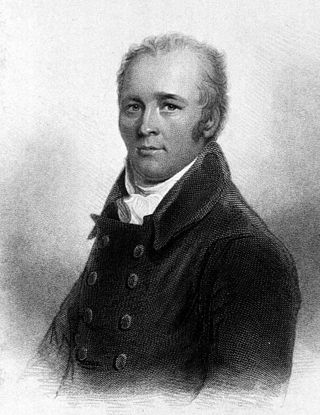
James Currie FRS was a Scottish physician, best known for his anthology and biography of Robert Burns and his medical reports on the use of water in the treatment of fever. A watercolour portrait by Horace Hone (1756–1825) is in the National Galleries of Scotland.

Balneotherapy is a method of treating diseases by bathing, a traditional medicine technique usually practiced at spas. Since ancient times, humans have used hot springs, public baths and thermal medicine for therapeutic effects. While it is considered distinct from hydrotherapy, there are some overlaps in practice and in underlying principles. Balneotherapy may involve hot or cold water, massage through moving water, relaxation, or stimulation. Many mineral waters at spas are rich in particular minerals such as silica, sulfur, selenium, and radium. Medicinal clays are also widely used, a practice known as 'fangotherapy'.
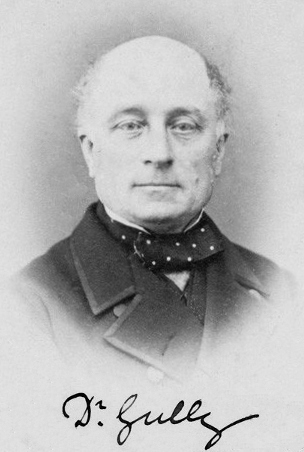
James Manby Gully was a Victorian medical doctor, well known for practising hydrotherapy, or the "water cure". Along with his partner James Wilson, he founded a very successful "hydropathy" clinic in Malvern, Worcestershire, which had many notable Victorians, including such figures as Charles Darwin and Alfred, Lord Tennyson, as clients.
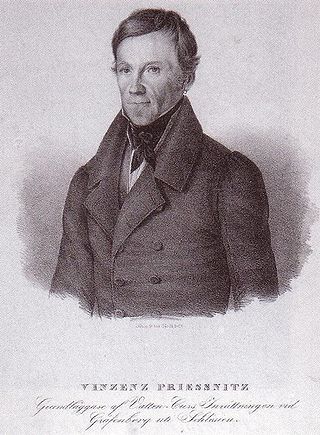
Vincenz Priessnitz, also written Prießnitz was a peasant farmer in Gräfenberg, Austrian Silesia, who is generally considered the founder of modern hydrotherapy, which is used in alternative and orthodox medicine. Priessnitz stressed remedies such as vegetarian food, air, exercise, rest, water, and traditional medicine. He is thus also credited with laying the foundations of what became known as Nature Cure, although it has been noted that his main focus was on hydrotherapeutic techniques. The use of cold water as a curative is recorded in the works of Hippocrates and Galen, and techniques such as spas, bathing, and drinking were used by various physicians in Europe and the US through to the 18th century. The practice was becoming less prevalent entering the 19th century however, until Priessnitz revived the technique after having major success applying it on patients in his spa in Gräfenberg. Priessnitz's name first became widely known in the English-speaking world through the publications and lecture tours of Captain R. T. Claridge in 1842 and 1843, after he had stayed at Grafenberg in 1841. However, Priessnitz was already a household name on the European continent, where Richard Metcalfe, in his 1898 biography, stated: "there are hundreds of establishments where the water-cure is carried out on the principles laid down by Priessnitz". Indeed, Priessnitz's fame became so widespread that his death was reported as far away as New Zealand.
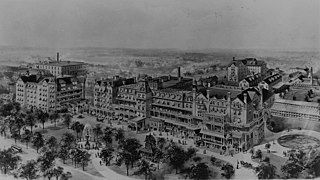
The Battle Creek Sanitarium was a world-renowned health resort in Battle Creek, Michigan, United States. It started in 1866 on health principles advocated by the Seventh-day Adventist Church and from 1876 to 1943 was managed by Dr. John Harvey Kellogg.
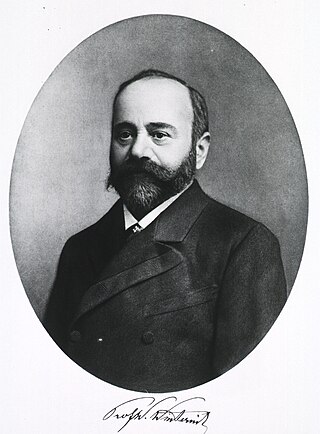
Wilhelm Winternitz, Josefov (Jaroměř) Josefstadt, Bohemia – February 22, 1917, Vienna) was a Czech-Austrian Jewish physician and hydropathist. He was an influential neurologist and hydropathist who at the time was commonly characterized as "the father of scientific hydrotherapy".
Captain Richard Tappin Claridge, FSA, was a prominent asphalt contractor and captain in the Middlesex UK Militia, who became best known for his prominent promotion of hydropathy, now known as hydrotherapy, in the 1840s. It was also known as the Cold Water system or Cold Water cure. Claridge is widely credited with introducing the methods of Vincent Priessnitz to England, thus initiating the populist movement of the time. Indeed, much of what is popularly known about Priessnitz in the English-speaking world comes from two seminal publications. Firstly, Claridge's Hydropathy; or The Cold Water Cure, as practised by Vincent Priessnitz.... Secondly, Richard Metcalfe's Life of Vincent Priessnitz (1898), with Metcalfe himself drawing upon Claridge, although Metcalfe also later wrote a historical overview and added more about Claridge and his role in the promotion of hydropathy.
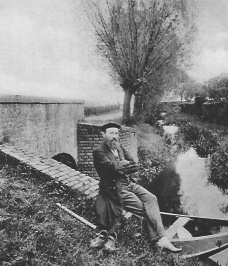
The Protestant pastor Leopold Erdmann Emanuel Felke was a naturopath who developed the eponymous Felke cure, and who was active in Repelen near Moers from 1896 to 1914 and in Bad Sobernheim from 1915 to 1925. He also practiced iris diagnosis (iridology) and is considered the co-father of combination homeopathic remedies.

Crieff Hydro is a hotel in Crieff, Perthshire, Scotland. The purpose-built hotel opened in 1868 as the Crieff Hydropathic Establishment, and is locally known as the Hydro. It was founded in 1868 by Dr Thomas Henry Meikle, who had received treatment at a centre in Gräfenberg, Austria, where Vincenz Priessnitz had built such an establishment. Preissnitz based his pharmacopeia on water, exercise, fresh mountain air, water treatments in the brooks and simple country food.

Simon Baruch was a physician, scholar, and the foremost advocate of the urban public bathhouse to benefit public health in the United States. He was a medical officer for the Confederate States army and after its defeat, a member of the Ku Klux Klan.

The County Hall is a municipal building in Matlock, Derbyshire, England. The building, which was originally a hydropathic establishment but is now the headquarters of Derbyshire County Council, is a Grade II listed building.

Russell Thacher Trall was an American physician and proponent of hydrotherapy, natural hygiene and vegetarianism. Trall authored the first American vegan cookbook in 1874.
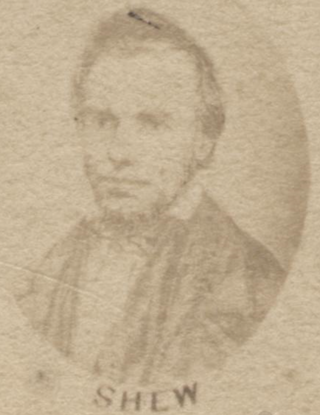
Joel Shew was an American physician, hydrotherapist and natural hygiene advocate.

Archibald Hunter was a Scottish hydrotherapist, naturopath and writer.

Ben Rhydding Hydro, opened as the Wharfedale Hydropathic Establishment and Ben Rhydding Hotel and later rebranded as the Ben Rhydding Golf Hotel was a hotel in Ben Rhydding near Ilkley, West Yorkshire, England, opened in 1844 and demolished in 1955.


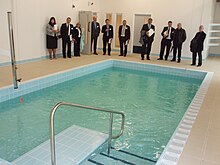
![James Currie, who, according to Captain R. T. Claridge, discovered "...the merit of settling the use of cold water...[and who established] the scientific base of Hydropathy" James Currie b1756.jpg](http://upload.wikimedia.org/wikipedia/commons/thumb/9/9f/James_Currie_b1756.jpg/170px-James_Currie_b1756.jpg)

